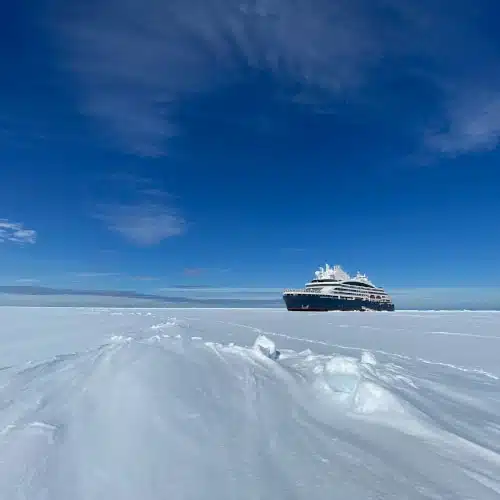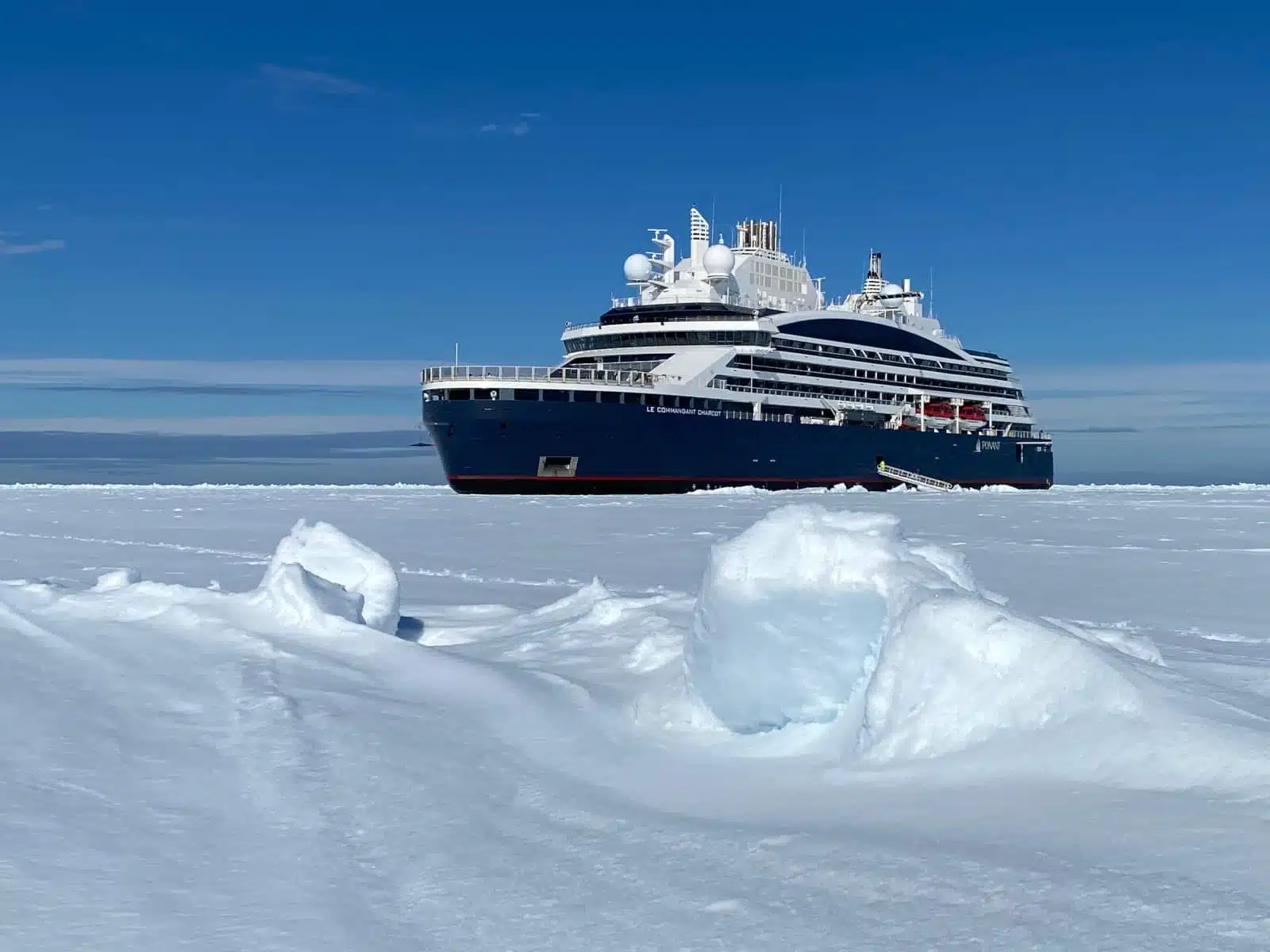Five great features!
Le Commandant Charcot makes unprecedented explorations possible, right in the heart of the polar regions. It will be the first French ship in history to reach the North Pole. Equipped with the latest technology available to minimise its environmental impact, this polar exploration cruise ship offers a unique experience, combining luxury, exploration, eco-friendly navigation and scientific research. Discover the five main innovative features of this extraordinary project.
Hybrid propulsion
Visiting the North Pole, crossing the Arctic Ocean and discovering the far north-east of Greenland, entering the Antarctic Circle and getting a close-up view of the immense Ross or Larsen Ice Shelves or even going in search of Emperor Penguin colonies: these dreams can now come true thanks to the first luxury cruise ship powered by natural gas, Le Commandant Charcot. “It would be unthinkable to use anything but the cleanest energy currently available, i.e. liquefied natural gas (LNG), to explore such places,” declares Mathieu Petiteau, Director of New Builds and Research & Development at PONANT. This propulsion system gives the ship greater autonomy and flexibility: the generator engines are dual fuel, which means they operate with both diesel fuel (LS MGO – Low Sulphur Marine Gas Oil) and LNG.
“Respect for the environment was an ever-present issue when designing the ship,” explains Thibaut Tincelin, naval architect at Stirling Design International. Two tanks capable of storing 4,500 m3 of LNG were integrated into the design from the outset.
The ship is also equipped with electric batteries to enable hybrid operation and an uninterrupted stable power supply, thus optimising the consumption of LNG and diesel and enabling smoke-free navigation without particulate emissions. “These solutions make Le Commandant Charcot the best polar vessel out there from an environmental standpoint,” says Thibaut Tincelin.
Getting as close as possible to the Poles in complete safety
Taking passengers to explore the icy seas requires a tremendous amount of preparation and forward-planning. In addition to the ship’s minimal environmental impact, it is its ability to navigate through the ice that makes Le Commandant Charcot so unique. While some cruise ships can get close to the sea ice, only the newest PONANT vessel is able to move safely between sheets of ice. Le Commandant Charcot is the world’s first passenger polar exploration cruise ship with a Polar Class 2 icebreaking rating. Its reinforced hull guarantees its safety in the event of an extreme situation – a privilege that was hitherto only reserved for certain transport ships and scientific expeditions. It also has two bridges, one at the front and one at the rear, and two powerful Azipod marine propulsion units enabling it to manoeuvre in any situation.
“To ensure it is as safe and efficient as possible, we have worked closely with Aker Arctic, the world leader in icebreaker vessels. Our mission was to inject their expertise into a ship designed for luxury cruising,” explains Thibault Tincelin.
An ice survival camp (that can be deployed on water or land) equipped with shelters and polar suits capable of accommodating all passengers for five days has also been designed specifically for Le Commandant Charcot. Emergency situation simulations were carried out with the Arctic Nations’ Search & Rescue (SAR) teams. “They were extremely successful. So successful in fact that the SAR teams want to develop the same tools. If our work can help others, so much the better! We made a lot of prototypes; it’s been quite a unique journey,” says Stanislas Devorsine, former captain of L’Astrolabe (the only French icebreaker until now), and actual captain aboard L’Austral.
Developing ice routing software
“It’s slow going when you’re surrounded by ice. You must have an intuitive understanding of weather data, anticipate how the ice will drift, be fully aware of what the boat is capable of and preserve it at all costs,” explains Stanislas Devorsine. In the past, explorers had no information whatsoever and had to rely on their observation skills to choose the right route. Navigating through the ice was a real test of strength and will.
Now, new technologies help with navigation: “Satellite images and helicopter tracking allow us to avoid polar lows, visualise the drifting ice and make accurate forecasts to choose the best route and consume as little energy as possible. (…) The ice routing software that we are going to use is also a world first and was developed specifically for PONANT by Adrena. I drew on my past as an offshore racer to develop an ice navigation strategy based on weather-related optimal route calculation tools,” adds Stanislas Devorsine.
An opportunity for scientific research and polar preservation
From the very start of this project, PONANT decided to make Le Commandant Charcot available to the scientific community in order to contribute to global efforts in the study and preservation of the Poles and oceans. Large areas have therefore been dedicated to dry and wet science labs, the hull has spaces for measuring instruments, and a moon pool inside the ship enables certain samples to be taken. All of this equipment has been designed to meet the requirements of academic research. In addition to this dedicated equipment, scientists will also be able to retrieve fish sonar data and data from an instrument that continuously measures and displays the thickness of the ice. Le Commandant Charcot thus offers a new platform for observation, research and analysis to scientists around the world, who will be able to study these difficult-to-access areas by regularly collecting data in these zones.
“There have been lots of discussions about sharing our data with the French marine hydrographic institute SHOM, which produces nautical charts. The Danes are also very interested in collecting cartographic information on eastern Greenland,” explains Stanislas Devorsine, who is delighted that Le Commandant Charcot will go down in history in the context of scientific exploration of the polar regions. Passengers will also be able to attend lectures led by onboard experts and participate in science sessions involving citizen contributions, “whether they involve observing whales, sending a probe or collecting a water sample. Doing science on a cruise ship is unheard of: we’re inventing something here!”
Eco-friendly solutions onboard
Keen to preserve these pristine spaces, PONANT continues to lead the way in developing eco-friendly onboard solutions. Like the rest of the fleet, Le Commandant Charcot has an advanced wastewater treatment system and the energy consumed on board is optimised: “We have transitioned from halogen lighting to light-emitting diodes (LEDs), reducing the energy we use for lighting by 75%,” adds Mathieu Petiteau. In addition, he suggested heating the benches and outdoor firepit using energy recovered from the ship’s exhaust fumes inspired by a trip to Ålesund, near the shipyard in Norway, where he discovered tubular benches filled with water heated by the town’s waste treatment plant.
To reduce waste and eliminate single-use plastics (plastic straws, cups, laundry bags and packaging), passengers will be provided with stainless steel drinking bottles. As part of this initiative, we have also implemented a Nordaq system to produce drinking water on board from seawater, distributing it via water fountains and recyclable glass bottles that are refilled and capped on board. Finally, the ship’s large waste storage capacity ensures that nothing is discharged during the journey. “Our passage must leave no trace; at the end of the journey, only our footprints should remain on the ice,” declares Mathieu Petiteau.
Crédits photos : ©PONANT/STIRLING DESIGN INTERNATIONAL, ©PONANT/Nicolas Dubreuil, ©PONANT/Wilmotte & Associés Architectes, ©PONANT/Studio PONANT
The Polar
Code
The Polar Code is the common name for the International Code for Ships Operating in Polar Waters, a regulation developed by the International Maritime Organization. It defines the rules and obligations of ships operating in remote polar areas in terms of construction, safety, crew training and ecosystem protection.

Reach the absolute
Embark on an exceptional polar odyssey aboard Le Commandant Charcot



